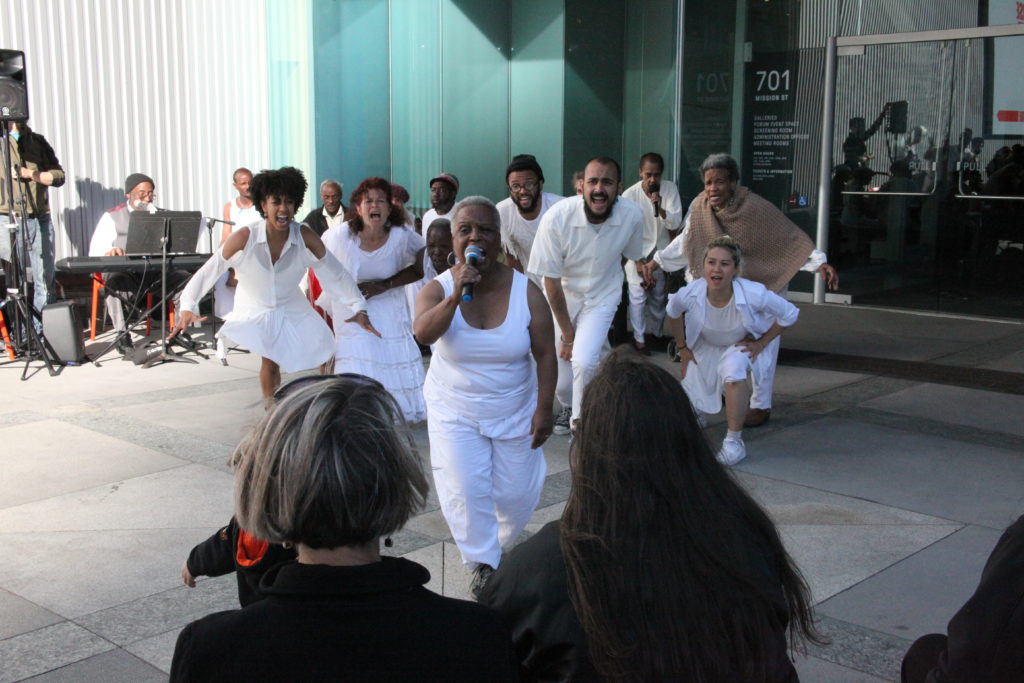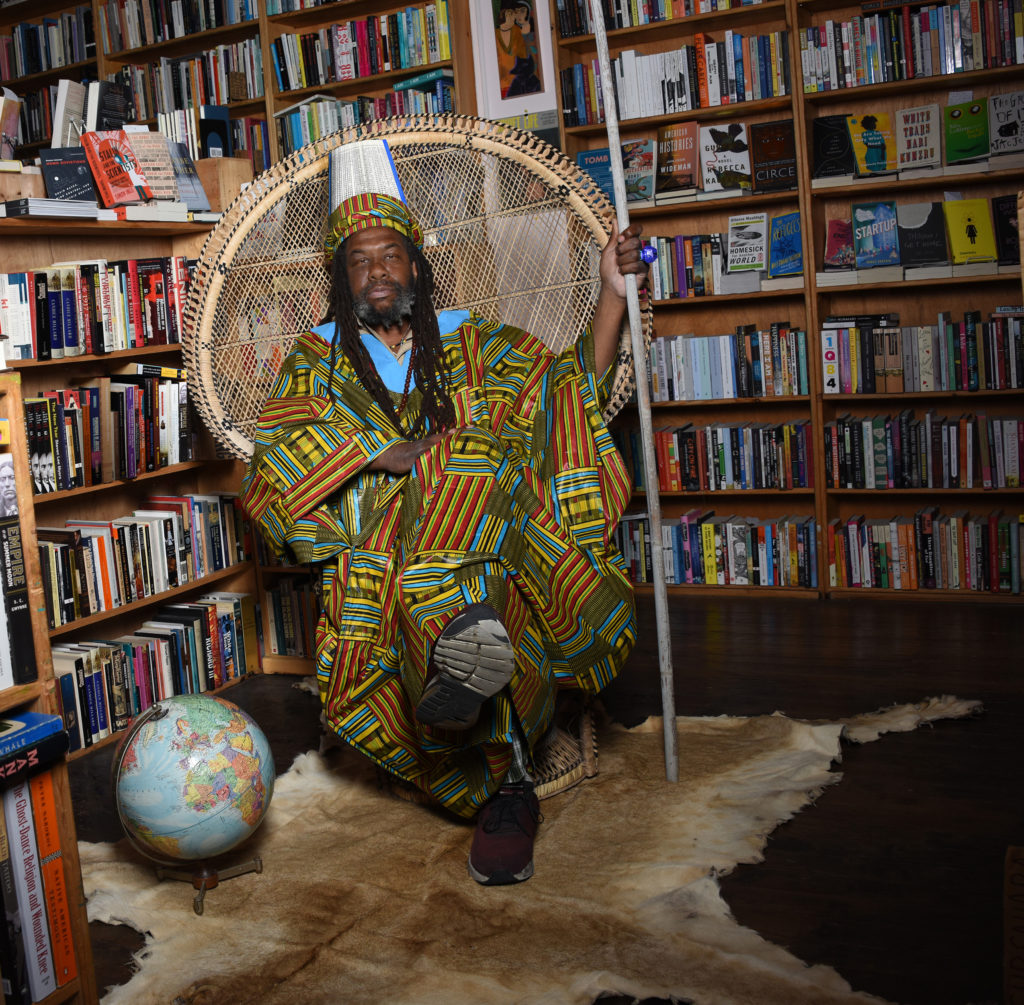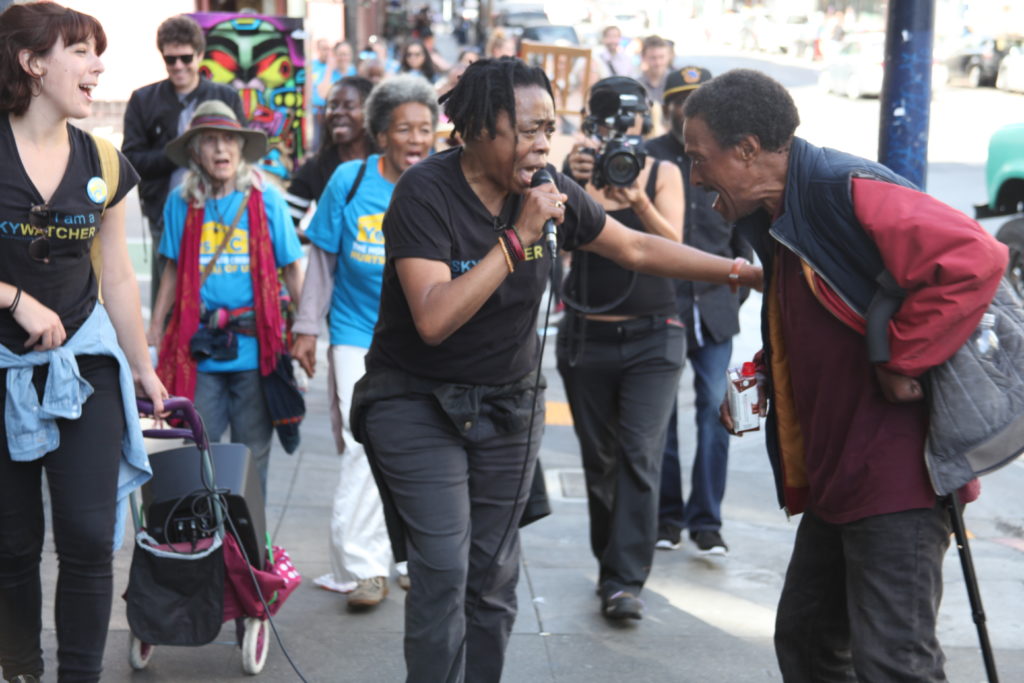Melanie DeMore is leading a procession from the Tenderloin to San Francisco City Hall. It’s the last Saturday in October, a little more than a week before Election Day, and a couple dozen people from the neighborhood—the majority associated with something called the Leadership Academy, a grassroots organizing effort instigated by Skywatchers in collaboration with GLIDE (where I work)—gather in Boeddeker Park to march together and cast their votes early.
But first they sing. Addressing the diverse group of men and women through a speaker strapped to a luggage cart, DeMore raises several choruses of “This Little Light of Mine.” Wearing a T-shirt that reads “I am a Skywatcher” and a loose braided bob that gracefully frames her open and expressive face, the company’s choral director goes on to remind everyone, in song, that “Everybody Here’s Got a Place at the Table.”
As if to underscore the point, a man wearing a motorcycle helmet studded with spikes comes over a few minutes later, yelling angrily at the proceedings. DeMore doesn’t hesitate to offer him the microphone, inviting him to say his piece, which he does, not too coherently but passionately, before quietly making his way out of the park again.
Now the group is moving out, too. DeMore, supported by other members of the Skywatchers ensemble, leads the marchers in song along a zigzagging route through some of San Francisco’s most densely populated, poverty-plagued, vibrant and varied streets—Eddy, Jones, Turk, Leavenworth, Golden Gate—inspiring responses from people on the sidewalks, some of whom raise their heads from seated or supine positions to nod approvingly, sing along, laugh, or join the line for a block or two.
The procession comes onto United Nations Plaza, pausing to speak and sing words of encouragement and solidarity to the homeless people gathered there at a time of increasing police presence in the area. Continuing on, the group crosses Larkin Street, passes through Civic Center Plaza, and arrives at the steps of City Hall, where they discover and rally alongside a youth group also assembled to vote en masse. Finally, everyone heads inside to cast their ballots.
This scene, over in a few hours, could easily have passed you by. But it leaves a trace of itself nonetheless—not least in votes cast by first-time voters from a neighborhood woefully underrepresented in government decision-making. Indeed, today’s action dovetails with a concerted effort by community groups, like Tenderloin Votes, to address that imbalance.
At a more fundamental level, today’s procession has been about relationship building—the M.O. of Skywatchers since 2011, when choreographer Anne Bluethenthal founded the Tenderloin-based company in collaborative partnership with residents of the Senator Hotel (a low-income permanent supportive housing building owned and operated by the non-profit Community Housing Partnership (CHP)) on the principle that “relationships are the first site of social change.”
This is a neighborhood that can use more of both.
For DeMore, a self-described “vocal activist” who has worked with Bluethenthal’s core company, ABD Productions, for over 20 years, the first point of relationship is always in song—especially among co-creators contending with various challenges that can include trauma and social isolation.
“People don’t feel like they have a voice, and that’s how they’re treated,” says DeMore in a recent phone conversation, “like they’re not even seen. So when I start working with a group, we just start singing. To give people permission. The only qualification you have to have is that you’re breathing. That’s pretty much it.”
While Skywatchers takes a multidisciplinary approach to its projects, nothing so readily illustrates its underlying philosophy as the choral music that remains a central element in its work.
“For a lot of people, it’s the first time that they’ve joined their voices together with others,” explains DeMore. “And it gives them strength. Every powerful movement in the world is pretty much led by song. You have to think about song as food. Song as fuel to keep you going ahead.”

“Tenderloin Processional” is just one of a long list of disparate actions, performances, installations, instigations, and interventions being staged throughout the Tenderloin and beyond—in public spaces, in single-room occupancy hotels (SROs), in the corridors of power, occasionally even in theaters—that together make up At the Table, Skywatchers’ two-year exercise in politically engaged community-based art.
At the Table extends Skywatchers’ community-driven work, while building ambitiously on its foundation of relationships and networks to claim space in the political sphere for its marginalized members and their neighbors, especially in the realm of supportive housing and laws and policies impacting the city’s homeless citizens.
Like Skywatchers’ work as a whole, At the Table is more about process than product. Nevertheless, it has produced a host of related actions and discrete productions.
Among them are forays into the physical landscape to highlight (and creatively overcome, in videos shot and edited by jose e. abad and Malia Byrne) instances of “unpleasant design,” those structures of deterrence in the built environment – such as subdivisions on benches that prevent reclining or speakers blaring classical music – that target homeless people, youth of color, and other members of the public deemed undesirable as parts of the social flow.
There’s also a publicly displayed series of large photographic portraits of Tenderloin residents called the Opulence Project (featuring photography by Deirdre Visser and direction by Adele Prandini) in which subjects imagine themselves without the constraints and tribulations of their daily lives and instead cast themselves into an imagined past/future of heroic possibility.
And there’s a series of home tours, “Inside the Iroquois Hotel,” on O’Farrell Street, made in collaboration with residents of this supportive housing community to bring wider public attention to the nature of life inside these vital sources of low-income housing in the Tenderloin.
The multifaceted project—grounded in daily collaboration between Tenderloin resident co-creators and Skywatchers’ seasoned community-practice artists Shakiri, Zulfikar Ali Bhutto, Gabriel Christian, Dazié Grego, and others—culminates in May in a three-day festival. The event will showcase much of the preceding two years’ work through documenting exhibits and performances, while crucially serving as an entry point for collective, creative action by other neighborhood residents and a forum for dialogue with neighborhood partners and city officials—all of it ultimately geared to shaping and advancing an agenda of, by and for the neighborhood’s residents.
The idea for At the Table takes its cue from the funding model of creative placemaking (although not uncritically), and came out of a conversation in the summer of 2016 between Anne Bluethenthal and Skywatchers’ then brand-new senior program manager, Clara Pinsky.
Pinsky had majored in dance at Wesleyan where her thesis explored community-based performance projects (including Skywatchers) as important strategies for equitable community development. She gained first-hand experience in such collaborative community-based projects while working as an assistant choreographer with Allison Orr’s acclaimed Forklift Danceworks in Austin.

Pinsky had been speaking with Anne Bluethenthal about Skywatchers for two years before moving out to San Francisco in June 2016 to work with the company. No sooner had she started than she saw a deadline for the National Endowment for the Arts’ “Our Town” creative placemaking grant looming.
“Clara had been working for a week,” remembers Bluethenthal, “and she said you have to apply for this. We had, by that point, this six-years body of work. It’s all about forefronting the voices of residents. And we now have stuff that people want to say. How do we get that in front of the right people? So that became the idea. How do we bring people to the table?”
“I had spent the last year-and-a-half researching creative placemaking and understanding the field, so it was really easy for me to translate what this program was already doing in the neighborhood into the terms of creative placemaking,” explains Pinsky, who with Bluethenthal has been a principal driving force behind the planning and management of At the Table.
“We were already making artworks that spoke to the lives of residents. That felt fundamentally important. We just need to frame [At the Table] as political work, and we need to leverage partnerships in the neighborhood to position it, so that the voices that we’re capturing in this art-making process are heard. That was the seed of it.”
Pinsky says that in envisioning the project, they quickly foregrounded the most salient issue emerging from the resident co-creators in years of regular Skywatchers meetings: the conditions of supportive housing.
“We’d been on that path,” notes Bluethenthal, “We had this experience with the Dialogue Project, a film project within the Community Housing Partnership, which was about bringing staff, upper administration, and residents to the same table to talk about the conditions.
“And now we embark on the next two years, in the same process, but creating new work with this particular idea,” she continues. “What are all the different strategies that we can bring to bear that help us not just do the work we’re doing but with an eye towards positioning that work in the political context more overtly?”
For the better part of the last two years, I have been a small part of the process, serving on an advisory board comprised of people from various Tenderloin community-based organizations, among them CHP, Coalition on Homelessness, Code Tenderloin, Faithful Fools, Tenderloin Neighborhood Development Corporation (TNDC), and GLIDE.
The group acts as a sounding board to Bluethenthal and Pinsky as they develop At the Table, and as liaisons to the organizations and coalitions in the neighborhood whose work resonates with the interests and goals of the project.
In fact, At the Table accrues to a larger collective effort underway among local residents, community organizers and anchor institutions—such as the Tenderloin People’s Congress and the Tenderloin Development Without Displacement Initiative—to support the neighborhood’s vulnerable populations in realizing their own collective power, and to stave off the forces of displacement and improve conditions for themselves and others living at the margins.
Such traces of self-awareness, connection and solidarity, which map onto what Pinsky refers to as the “relational ecosystem” of the neighborhood, might be the most significant short-term result from the preceding two years’ work. At the same time, as “outcomes” they are notably hard to quantify.

“They’re not what you would normally put in a grant,” admits Bluethenthal, during a conversation in March. “But here’s the thing: We are actually creating structure. I mean literally. People come and they say, ‘This is the thing that I count on every week. There’s very little structure in my life. And I know I can count on every Wednesday afternoon that there will be a loving community here.’ That to me is kind of remarkable, because I feel like it’s so little, but it means so much.”
“So (a) the structure (b) the relationships and (c) the art,” she says, summing up the deliverables from the hard work of the last several years. We’re in dialogue often about things that are very difficult or challenging or even traumatic. And this becomes the material. We’re making something, out of ourselves, each week—song or poetry or movement. I actually feel it has its own beauty and ‘just rightness’ [but] just the act of doing it is life-affirming. The act of doing it together is community-building. And the glue of the whole thing is that we’re generating love.”
How does a process like this conclude in one three-day festival?
It doesn’t, admits Bluethenthal. “It’ll just evolve into something else.”
This article appeared in the May 2019 issue of In Dance.


